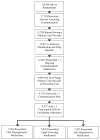Communication and medication refill adherence: the Diabetes Study of Northern California
- PMID: 23277199
- PMCID: PMC3609434
- DOI: 10.1001/jamainternmed.2013.1216
Communication and medication refill adherence: the Diabetes Study of Northern California
Erratum in
- JAMA Intern Med. 2013 May 13;173(9):731
Abstract
Background: Poor medication refill adherence contributes to poor cardiometabolic control and diabetes outcomes. Studies linking communication between patients and health care providers to adherence often use self-reported adherence and have not explored differences across communication domains or therapeutic indications.
Methods: To investigate associations between patient communication ratings and cardiometabolic medication refill adherence, we conducted a cross-sectional analysis of 9377 patients in the Diabetes Study of Northern California (DISTANCE), a race-stratified, random sample of Kaiser Permanente survey respondents. Eligible participants received 1 or more oral hypoglycemic, lipid-lowering, or antihypertensive medication in the 12 months preceding the survey. Communication was measured with a 4-item Consumer Assessment of Healthcare Providers and Systems Survey (CAHPS) score and 4 items from the Trust in Physicians and Interpersonal Processes of Care instruments. Poor adherence was classified as greater than a 20% continuous medication gap for ongoing medication therapies. Using modified least squares regression, we calculated differences in poor adherence prevalence for a 10-point decrease in CAHPS score and compared higher vs lower communication ratings on other items, adjusting for necessary sociodemographic and medical confounders derived from a directed acyclic graph.
Results: In this cohort, 30% had poor cardiometabolic medication refill adherence. For each 10-point decrease in CAHPS score, the adjusted prevalence of poor adherence increased by 0.9% (P=.01). Compared with patients offering higher ratings, patients who gave health care providers lower ratings for involving patients in decisions, understanding patients' problems with treatment, and eliciting confidence and trust were more likely to have poor adherence, with absolute differences of 4% (P=.04), 5% (P=.02), and 6% (P=.03), respectively. Associations between communication and adherence were somewhat larger for hypoglycemic medications than for other medications.
Conclusions: Poor communication ratings were independently associated with objectively measured inadequate cardiometabolic medication refill adherence, particularly for oral hypoglycemic medications. Future studies should investigate whether improving communication skills among clinicians with poorer patient communication ratings could improve their patients' cardiometabolic medication refill adherence and outcomes.
Conflict of interest statement
None of the authors had conflicts of interest, and the funders had no role in design and conduct of the study; collection, management, analysis, and interpretation of the data; or preparation, review, or approval of the manuscript.
Figures


Comment in
-
On the road to patient centeredness.JAMA Intern Med. 2013 Feb 11;173(3):218-9. doi: 10.1001/jamainternmed.2013.1229. JAMA Intern Med. 2013. PMID: 23277229 No abstract available.
References
-
- Kerr EA, Zikmund-Fisher BJ, Klamerus ML, Subramanian U, Hogan MM, Hofer TP. The role of clinical uncertainty in treatment decisions for diabetic patients with uncontrolled blood pressure. Ann Intern Med. 2008;148(10):717–727. - PubMed
-
- Heisler M, Hogan MM, Hofer TP, Schmittdiel JA, Pladevall M, Kerr EA. When more is not better: Treatment intensification among hypertensive patients with poor medication adherence. Circulation. 2008;117(22):2884–2892. - PubMed
Publication types
MeSH terms
Substances
Grants and funding
LinkOut - more resources
Full Text Sources
Other Literature Sources
Medical
Miscellaneous

